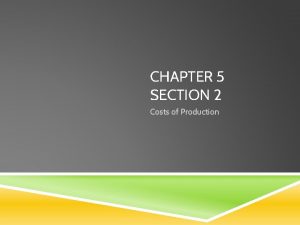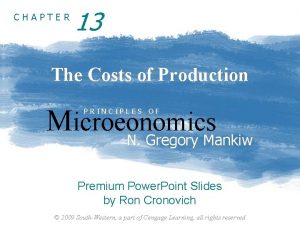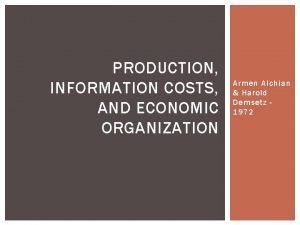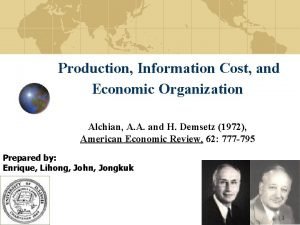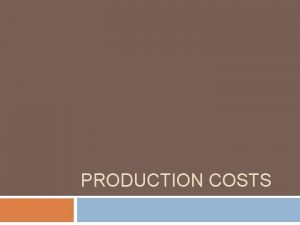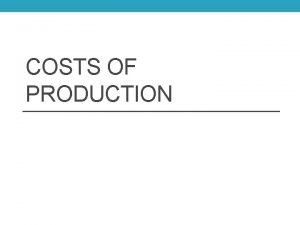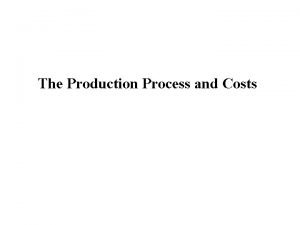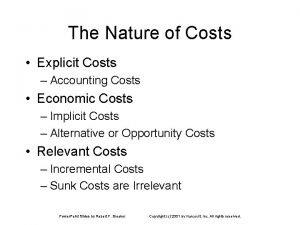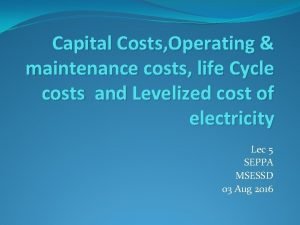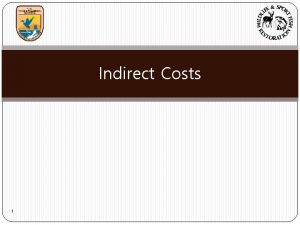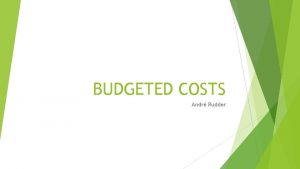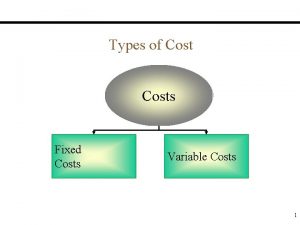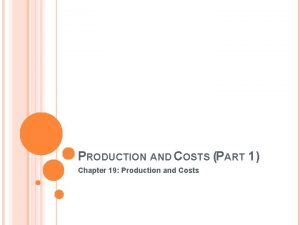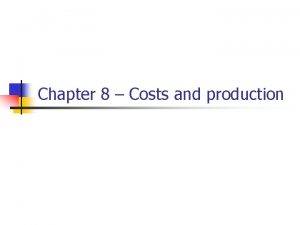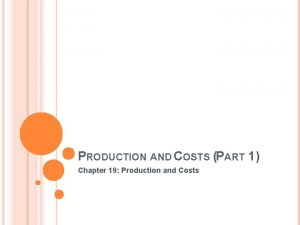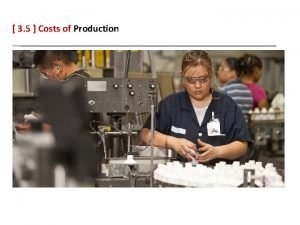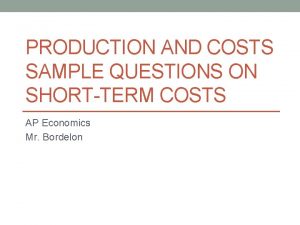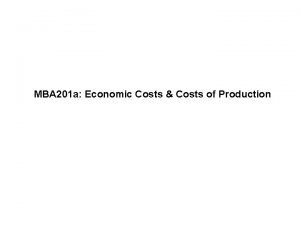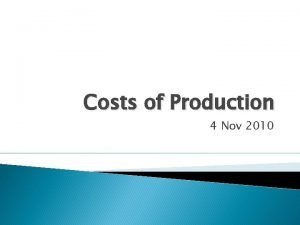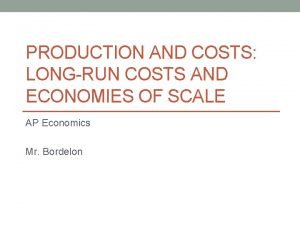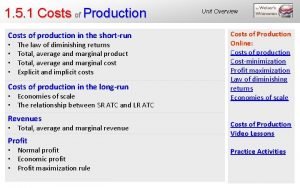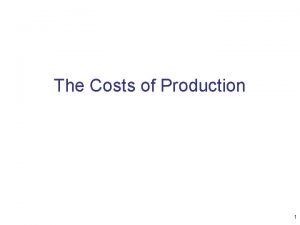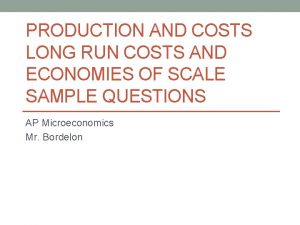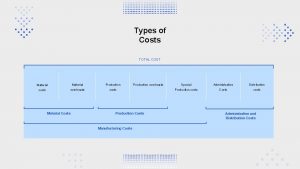22 CHAPTER The Costs of Production I COSTs


































- Slides: 34

22 CHAPTER The Costs of Production

I. COSTs 1) Accounting Costs Explicit costs 2) Economic Costs Explicit costs + Implicit costs

ØDefinitions: Explicit costs • The monetary payments a firm must make to those who supply it. Implicit costs • Are the opportunity costs, or are the money payments the self‑employed resources could have earned in their best alternative employments ( foregone wage, interest, rent, and entrepreneurial income ) Economic costs • The payment the firm must make or income it must provide to attract resources away from alternative production opportunities Profit • Total Revenue –Total Cost=Accounting Profit or Economic Profit • Accounting Profit= TR-Explicit Costs • Economic Profit=TR- (Explicit Costs+ Implicit Costs)

Numerical Example • Ali runs a small firm. He hires one labor at $12, 000 per year, pays annual rent of $5, 000 for his shop, and spends $20, 000 per year on materials. • He has $40, 000 of his own funds invested in equipments that could earn him $4, 000 per year if alternatively invested. He has been offered $15, 000 per year to work as a manager for a competitor. He also estimates his entrepreneurial talents are worth $3, 000 per year. • Total annual revenue from his firm sales is $72, 000. q Calculate the explicit and implicit costs? q Calculate the accounting and economic profits?

ØECONOMIC COSTS Economic (opportunity) Costs Profits to an Economist Economic Profit Implicit costs (including a normal profit) Explicit Costs Profits to an Accountant T O T A L R E V E N U E Accounting Profit Accounting costs (explicit costs only)

ØSHORT RUN AND LONG RUN -Accounting: Short and long run is based upon annual fiscal year -Economics: Short run has fixed plant capacity size Long run has variable plant capacity size

II. SHORT-RUN PRODUCTION RELATIONSHIPS ØDefinitions: -Total Product (TP) Total quantity or total output of a particular good or service produced -Marginal Product (MP) o Once one more labor added, what will happen to the TP o MP can be measured as the following: Marginal Product = Change in Total Product Change in Labor Input -Average Product (AP) AP can be measured as : Average Product = Total Product Units of Labor

Numerical Example: suppose a fixed amount of capital, the firm can produce chairs according to the following costs: Variable resource (labor) Total product 0 1 2 3 4 5 6 7 8 0 10 25 45 60 70 75 75 70 Marginal product Average product 10 15 20 15 10 5 0 -5 10 12. 5 15 15 14 12. 5 10. 71 8. 75 Comments Increasing marginal returns Diminishing marginal returns Negative marginal returns

ØLaw of diminishing marginal returns As successive units of a variable resource are added to a fixed resource, beyond some point, the extra, or marginal product that can be attributed to each additional unit of the variable resource will decline WHY?

ØShort Run Production and the law of Diminishing Marginal Returns-Graphically Average Product, AP, and marginal product, MP Total Product, TP Law of Diminishing Returns Total Product Quantity of Labor Increasing Marginal Returns Average Product Marginal Product

ØShort Run Production and the law of Diminishing Marginal Returns-Graphically Average Product, AP, and marginal product, MP Total Product, TP Law of Diminishing Returns Total Product Quantity of Labor Diminishing Marginal Returns Average Product Marginal Product

ØShort Run Production and the law of Diminishing Marginal Returns-Graphically Average Product, AP, and marginal product, MP Total Product, TP Law of Diminishing Returns Total Product Quantity of Labor Negative Marginal Returns Average Product Marginal Product

III. SHORT RUN PRODUCTION COSTS ØDefinitions: -Total Fixed Costs: Costs that do not vary with changes in output -Average Fixed Costs: Average Fixed Costs = Total Fixed Costs Quantity -Total Variable Costs: Costs that vary with changes in output -Average Variable Costs: Average Variable Costs = Total Variable Costs Quantity

-Total Costs: Total Fixed and Variable Costs - Average Total Costs Average Total Cost = -Total Marginal Costs: Marginal Cost = Change in Total Costs Change in Quantity Total Costs Quantity

Numerical Example: suppose a fixed amount of capital, the firm can produce chairs according to the following costs: Total Product Total Fixed Costs Total Variable Costs Total Costs 0 1 2 100 100 0 90 170 100 190 270 3 4 5 6 7 8 9 10 100 100 240 300 370 450 540 650 780 930 340 400 470 550 640 750 880 1030

Total Product 0 1 2 3 4 5 6 7 8 9 10 Average Fixed Costs Average Variable Costs Average Total Costs Marginal Costs 100 50 33. 33 25 20 16. 67 14. 29 12. 50 11. 11 10 90 85 80 75 74 75 77. 14 81. 25 86. 67 93 190 135 113. 33 100 94 91. 67 91. 43 93. 75 97. 78 103 90 80 70 60 70 80 90 110 130 150

ØSummary of Definitions Total Fixed Costs = Total Variable Costs = Total Costs = Average Fixed Costs = Average Variable Costs = Average Total Costs = Marginal Cost = TFC TVC TC AFC AVC ATC MC

Costs (dollars) SHORT-RUN COSTS GRAPHICALLY Combining TVC With TFC to get Total Cost TC TVC Fixed Cost Variable Cost TFC Quantity

SHORT-RUN COSTS GRAPHICALLY Costs (dollars) MC Plotting Average and Marginal Costs ATC AVC AFC Quantity

Average product and marginal product PRODUCTIVITY AND COST CURVES AP MP Costs (dollars) Quantity of labor MC Quantity of output AVC

IV. LONG-RUN PRODUCTION COSTS For every plant capacity size. . . There is a short-run ATC curve All such plant capacities can be plotted. . .

Unit Costs LONG-RUN PRODUCTION COSTS Output

Unit Costs LONG-RUN PRODUCTION COSTS Output

Unit Costs LONG-RUN PRODUCTION COSTS The Long-run ATC just “envelopes” all of the short-run ATC curves Output

Unit Costs LONG-RUN PRODUCTION COSTS Long-run ATC Output

ØECONOMIES AND DISECONOMIES OF SCALE Unit Costs Economies of scale Long-run ATC Output

Constant returns to scale Unit Costs Economies of scale Long-run ATC Output

Constant returns to scale Diseconomies of scale Unit Costs Economies of scale Long-run ATC Output

Economies of scale • Labor specialization: working at fewer tasks workers become efficient in them. Greater labor specialization eliminates the loss of time that accompanies each shift of a worker from one task to another • Managerial specialization: small firms can’t use management specialists to best advantages. Large companies can use specialists full time, which means greater efficiency and lower costs

Economies of scale • Efficient capital. Large firms can afford the most efficient equipments, these requires high volume of production and large scale producers, e. g. , car robots. • Other factors: design and development and other startup costs,

Diseconomies of scale • The main reason is difficulty of efficiently controlling and coordinating a firms operation when it becomes large.

Constant returns of scale • Effect of factors of economies and factors of diseconomies is equal. • Minimum efficient size: The lowest level of output at which a firm can minimize long run average costs.

ECONOMIES AND DISECONOMIES OF SCALE Unit Costs Where extensive economies of scale exist: Natural Monopolies. Long-run ATC Output

Unit Costs ECONOMIES AND DISECONOMIES OF SCALE Where economies of scale are quickly exhausted Long-run ATC Output
 Post production workflow diagram
Post production workflow diagram Chapter 5 section 2 costs of production
Chapter 5 section 2 costs of production Mankiw chapter 13
Mankiw chapter 13 Production, information costs, and economic organization
Production, information costs, and economic organization Types of production costs
Types of production costs Production information costs and economic organization
Production information costs and economic organization Hát kết hợp bộ gõ cơ thể
Hát kết hợp bộ gõ cơ thể Lp html
Lp html Bổ thể
Bổ thể Tỉ lệ cơ thể trẻ em
Tỉ lệ cơ thể trẻ em Chó sói
Chó sói Thang điểm glasgow
Thang điểm glasgow Hát lên người ơi alleluia
Hát lên người ơi alleluia Các môn thể thao bắt đầu bằng từ đua
Các môn thể thao bắt đầu bằng từ đua Thế nào là hệ số cao nhất
Thế nào là hệ số cao nhất Các châu lục và đại dương trên thế giới
Các châu lục và đại dương trên thế giới Công thức tiính động năng
Công thức tiính động năng Trời xanh đây là của chúng ta thể thơ
Trời xanh đây là của chúng ta thể thơ Mật thư tọa độ 5x5
Mật thư tọa độ 5x5 Làm thế nào để 102-1=99
Làm thế nào để 102-1=99 độ dài liên kết
độ dài liên kết Các châu lục và đại dương trên thế giới
Các châu lục và đại dương trên thế giới Thơ thất ngôn tứ tuyệt đường luật
Thơ thất ngôn tứ tuyệt đường luật Quá trình desamine hóa có thể tạo ra
Quá trình desamine hóa có thể tạo ra Một số thể thơ truyền thống
Một số thể thơ truyền thống Cái miệng xinh xinh thế chỉ nói điều hay thôi
Cái miệng xinh xinh thế chỉ nói điều hay thôi Vẽ hình chiếu vuông góc của vật thể sau
Vẽ hình chiếu vuông góc của vật thể sau Nguyên nhân của sự mỏi cơ sinh 8
Nguyên nhân của sự mỏi cơ sinh 8 đặc điểm cơ thể của người tối cổ
đặc điểm cơ thể của người tối cổ Ví dụ về giọng cùng tên
Ví dụ về giọng cùng tên Vẽ hình chiếu đứng bằng cạnh của vật thể
Vẽ hình chiếu đứng bằng cạnh của vật thể Vẽ hình chiếu vuông góc của vật thể sau
Vẽ hình chiếu vuông góc của vật thể sau Thẻ vin
Thẻ vin đại từ thay thế
đại từ thay thế điện thế nghỉ
điện thế nghỉ

